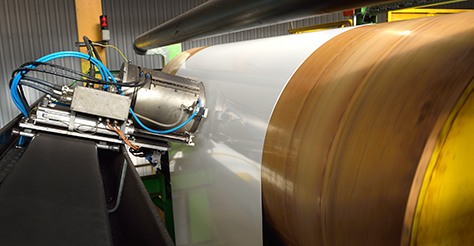-
Continuous measuring of the paint layer thickness
When ordering pre-painted steel, our customers indicate the required thickness of the paint layer. We closely follow-up on these measurements in our organic coating lines.

In the organic coating lines, we are able to apply different types of paint onto our steel. Depending on the final applications, we can for instance add polyester paint, polyurethane or plastisol. But we are also able to add weldable zinc primers to the paint, which are mainly used in the automotive industry.
The optical principle
We first degrease our steel and pre-treat it with a product that improves the adhesion of the paint on the zinc layer. Usually this is a chomate layer but chrome-free products can be added as well. The pre-treatment layers are applied to the steel with a roller before being dried, cooled and sent through the thickness tester.
A comparable device is located behind the primer oven. Both devices – using UV spectroscopy- continuously measure the layer thicknesses of the primer and backcoat paints. These base layers usually have a thickness of 7 to 10 microns.
How does it work?
Using fibre optic cables and a system of mirrors, we shine xenon light from our light source to the measuring head, which moves back and forth across the paint layer. A reflector conducts the beam onto an elliptical mirror, which then projects the light onto the surface being measured. The light that returns from the measurement surface is combined by the mirror and conveyed to the spectrophotometer via fibre optic cables. The meter compares the light received to the light transmitted.
The thickness meters are capable of measuring paint layers of up to 7µ. We have a specific reference curve for each type of paint.To prevent drift, we recalibrate the meters every four hours using a reference surface.
-
More on process innovation


